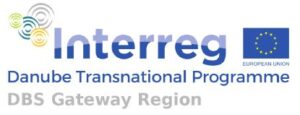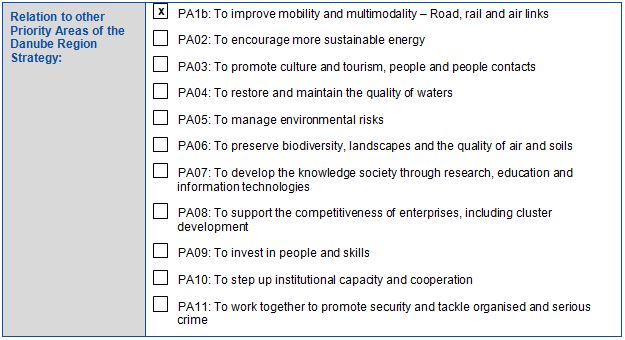BASIC PROJECT DATA
Project ID: PA1A119
Project website: www.interreg-danube.eu/dbs-gateway-region
NEED AND ADDED VALUE FOR DANUBE REGION STRATEGY
At present, aging infrastructure and inefficient, non-transparent intermodal services limit the potential of the water transport system. The project is built upon the belief that the cooperation of public authorities, ports and their related associations is the key success factor in order to raise quality, reliability and efficiency of the waterway transport system.
OBJECTIVE(S) OF THE PROJECT
DBS Gateway Region project aimed at supporting the Danube-Black Sea region to become an attractive gateway region for maritime and inland waterway transport between Central Europe and the Black Sea, the Caspian region and the Far East by facilitating increased intensity and quality of cooperation between ports, regions and other key actors.
The joint effort aimed to improve accessibility of both the ports and the region and strengthen interoperability between maritime and inland waterways as well as with their hinterland. Together with raising the awareness of the possibilities of intermodal transport, this should lead to shifting existing and attracting new cargo flows to environmentally friendly transport systems.
Cooperation in itself will not yet lead to the envisaged results. It needs to be elevated to a well-informed (Potential Analysis, Road Map), well-prepared (list of projects ready to be implemented, Funding Guideline), well-focused (Joint Vision, Joint Cooperation Strategy) and well-supported (Cooperation Platform beyond the lifetime of the project) level.
The specific objectives of the project accommodate this fact:
- The project aimed at creating a basis for cooperation between the relevant stakeholders in order to be able to work together towards the development of the DBS Gateway Region.
- Through increased attractiveness of the waterway transport system, it aimed at providing the preconditions for the region to take over the envisaged role as DBS Gateway Region.
- In order to be able to further develop and promote the DBS Gateway Region beyond the lifetime of the project, it aimed at facilitating long-term cooperation of all key actors within an institutionalised platform.
CONDUCTED PROJECT ACTIVITIES
Complex challenges require a multidisciplinary approach. The core working group consisted of the financing partners that ensured the involvement of public authorities (cities, regions and ministries), ports and their associations as well as the academic background of a university. They brought together all key actors competent to successfully work towards a better connected and interoperable DBS Gateway Region.
In order to strengthen the cooperation and the commitment to work together towards the Joint Vision, the methodology intended the incorporation of other relevant stakeholders in the region through regional workshops, feedback-loops and direct input to relevant topics.
The methodology combined both bottom-up and top-down approach:
- First, the project started bottom-up in order to assure that it meets regional needs and that all existing information is used and built upon: The project took advantage of all sources of information, including desktop research of previous studies and analyses, studies of previous studies and analysis, adding additional statistical data as well as using adequate formats of stakeholder participation for specific input.
- Based on the grounds of common challenges and needs, the elaboration of a Joint Vision for the whole DBS Gateway Region lifts the project on the transnational level. The Roadmap is another transnational document (using existing plans and policies) for identifying measures suitable to reach the Joint Vision.
- The third step followed the top-down approach and aimed to bring the Roadmap down to regional level again in order to raise regional commitment and break down the transnational measures to concrete actions for implementation (Regional Action Plans).
In parallel, the set-up of the Cooperation Platform was done in a collaborative approach including all partners throughout the process. This methodology ensures that the Platform has a clear joint vision, joint strategy and joint agenda whilst legitimised by all partners that support it with a strong commitment.
TRANSBOUNDARY IMPACT
The partnership consisted of 10 Financing Partners and 20 Associated Strategic Partners and involved all riparian countries of the Danube river.
The partnership not only included ports and their related associations, but also national, regional and local authorities to widen the perspective from port infrastructure to hinterland connections. Ports are seen as important hubs and their accessibility to and from the region is an essential factor. Cities, regions and ministries should integrate recommendations of the project into their local, regional and national policies and thus are important.
The partnership followed an innovative approach by building an umbrella for all relevant stakeholders. One representative of each participating region was nominated financial partner. His task was to involve all other stakeholders in his region, get their feedback and report to the core group. This approach ensured the proper involvement of all stakeholders.
PROJECT BENEFICIARIES / TARGET GROUPS
- ports and related associations
- national, regional and local authorities
- cities, regions and ministries
STATUS AND TIMEFRAME
Start date: 01.01.2017
End date: 30.06.2019
The project is already concluded.
FINANCING
Total budget: 2,178,449.30 EUR
EU funds: 1,652,352.65 EUR (ERDF – European Regional Development Fund)
199,329.25 EUR (IPA – Instrument for Pre-Accession Assistance)
funded by Danube Transnational Programme (DTP) 2014 – 2020
National funds: 326,767.40 EUR
PROJECT TEAM
Project leader: Regional Government of Lower Austria
(website: www.noel.gv.at)
Address: Landhaus 1, Haus 16, 3109 St. Pölten / Austria
Project partners:
- Bayernhafen GmbH & Co (DE)
- ecoplus. The Business Agency of Lower Austria (AT)
- Port of Vienna (AT)
- Vienna, Municipal Department for Urban Development and Planning (AT)
- Austrian Association of Cities and Towns (AT)
- Federal Ministry of Transport, Innovation and Technology (AT)
- Working Community of Danube Regions (AT)
- Bratislava, Self-governing region (SK)
- Hungarian Federation of Danube Ports (HU)
- Association of Hungarian Logistics Service Centers (HU)
- Ministry of Development Hungary (HU)
- Ministry of Maritime Affairs, Transport and Infrastructure (HR)
- Port of Vukovar (HR)
- Port of Novi Sad (RS)
- Autonomous Province of Vojvodina (RS)
- Port of Varna (BG)
- Ministry of Transport, Information Technology and Communications (BG)
- The River Administration of the Lower Danube Galati (RO)
- Ministry of Transport and Road Infrastructure (MD)
- Izmail Branch of state enterprise „Ukrainian Sea Ports Authority“ (UA)
EUSDR EMBEDDING
EUSDR COMPLIANCE
META DATA
Data provided by: Christian Popp (Regional Government of Lower Austria) – 25.09.2017
Download pdf




